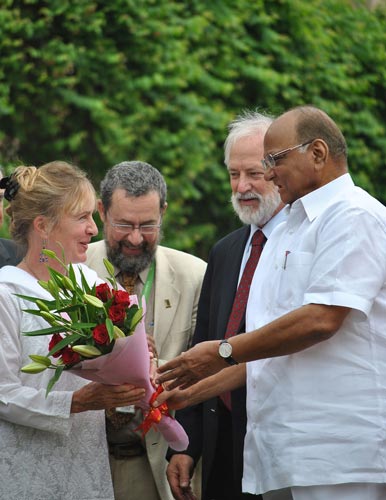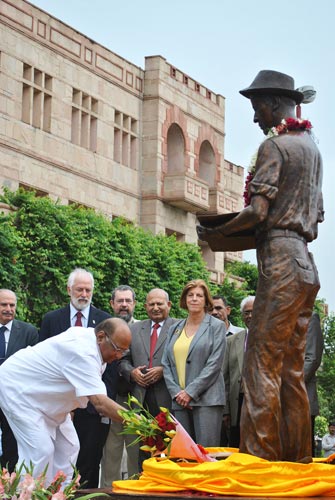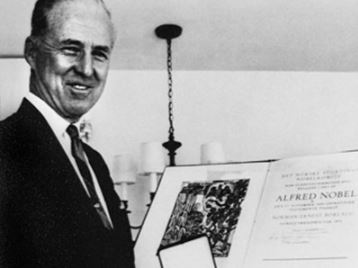
By Miriam Shindler, CIMMYT
The Honorable Shri Sharad Pawar, India’s Minister of Agriculture, and Jeanie Borlaug Laube, daughter of the late Dr. Norman E. Borlaug, unveiled a statue of Borlaug at the National Agricultural Science Complex in Delhi on 19 August. Working for its precursor and later CIMMYT, Borlaug developed semi-dwarf, disease-resistant wheat varieties and led the introduction of these high-yielding varieties combined with modern agricultural production techniques in Mexico, India and Pakistan. As a result, Mexico became a net exporter of wheat by 1963. Between 1965 and 1970, wheat yields nearly doubled in India and Pakistan, greatly improving food security in those nations. These collective increases in yield have been labeled the Green Revolution, and Borlaug is often called the “Father of the Green Revolution” and credited with saving more than 1 billion people worldwide from starvation. Borlaug was awarded the 1970 Nobel Peace Prize in recognition of his work and contributions to world peace through an increased food supply.

The CIMMYT-commissioned statue was donated to the people and scientists of India as a gift to mark 50 years of partnership (Dr. Borlaug introduced his new wheat varieties in India in 1963). The statue leaves a permanent reminder of Dr. Borlaug’s achievements and a legacy for the future. The statue was handmade by the artist Katharine McDevitt, professor of sculpture at Universidad Autónoma Chapingo (Chapingo Autonomous University) in the Mexican State of Texcoco. It is the oldest agricultural university in the Americas and is also where Dr. Borlaug started his research in Mexico in 1944, sleeping on the floor of a university barn. The Borlaug statue holds a book inscribed with the names of some of the leading visionaries who worked with him during the “Green Revolution” – M.S. Swaminathan, C. Subramaniam, B. Sivaraman, A.B. Joshi, S.P. Kohli, Glenn Anderson, M.V. Rao andV.S. Mathur. It also contains a list in Latin and Hindi script of the original Mexican wheat varieties that were so productive in India. Speaking at the event, Dr. Thomas Lumpkin, Director General of both CIMMYT and the Borlaug Institute of South Asia, said, “In his vigorous support for an agricultural revolution in South Asia and his passion for understanding their circumstances, Norm won the hearts of Indian farmers and helped deliver 50 years of food security to the region. The National Agricultural Science Complex, where Norm spent a lot of his time in India, is a fitting place for this statue, and hopefully will inspire a new generation of scientists to conquer the great new challenges facing the country and the region.”
 Nutrition, health and food security
Nutrition, health and food security 

